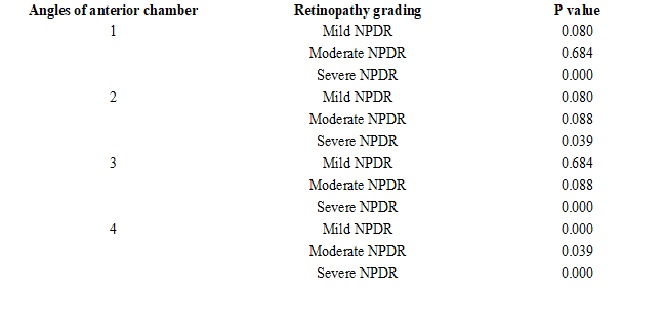Study of angle of anterior chamber in patients with Type 2 Diabetes Mellitus
Abstract
Introduction: Open angle Glaucoma is one of the causes of blindness in diabetic patients. Whether diabetes is a risk factor for angle closure glaucoma also is less thoroughly studied.
Objectives: To assess the angle of anterior chamber in patients with type 2 diabetes mellitus.
Materials and Method: 125 patients (250 eyes) who met the inclusion criteria were taken up for the study. Patients of both sexes and more than 40 years of age with Type 2 Diabetes Mellitus who do not come under the exclusion criteria were included.
Results: In subjects with duration of diabetes <5 years, Grade 4 angle was found in 47.41% of eyes which was comparatively more than the other grades. When the duration of Diabetes was 5-10 years, 40% of the eyes had Grade 4 angle and 37.27% had Grade 3 angle. In subjects with >10 years duration of diabetes, 33.33% had Grade 3 angle. Grade 2 and Grade 4 angles were of equal distribution with 29.16% and Grade 1 was found to be less. The association of Grade 1 and Grade 3 angle with severe non-proliferative diabetic retinopathy was found to be statistically significant. Whereas, in patients with mild diabetic retinopathy and in moderate non-proliferative diabetic retinopathy Grade 4 angle is statistically significant.
Conclusion: This study thus concludes the grade of angle of the anterior chamber decreases as the diabetic retinopathy advances.
Downloads
References
2. Saw SM, Wong TY, Ting S, et al. The relationship between anterior chamber depth and the presence of diabetes in the Tanjong Pagar Survey. Am J Ophthalmol. 2007 Aug;144(2):325-6.DOI:10.1016/j.ajo. 2007.03.038.
3. Standards of Medical Care in Diabetes. Diabetes Care 2010:33(1):11-61.
4. American Diabetes Association. Diagnosis and classification of diabetes mellitus. Diabetes Care. 2008 Jan;31 Suppl 1:S55-60. doi: 10.2337/dc08-S055.[pubmed]
5. Løgstrup N, Sjølie AK, Kyvik KO, et al. Long-term influence of insulin dependent diabetes mellitus on refraction and its components: a population based twin study. Br J Ophthalmol. 1997 May;81(5):343-9.[pubmed]
6. Tai MC, Lin SY, Chen JT, et al. Sweet hyperopia: refractive changes in acute hyperglycemia. Eur J Ophthalmol. 2006 Sep-Oct;16(5):663-6.[pubmed]
7. Williams DL. Lens morphometry determined by B-mode ultrasonography of the normal and cataractous canine lens. Vet Ophthalmol. 2004 Mar-Apr;7(2):91-5.[pubmed]
8. Devereux JG, Foster PJ, Baasanhu J, et al. Anterior chamber depth measurement as a screening tool for primary angle-closure glaucoma in an East Asian population. Arch Ophthalmol. 2000 Feb;118(2):257-63.[pubmed]
9. Foster PJ, Devereux JG, Alsbirk PH, et al. Detection of gonioscopically occludable angles and primary angle closure glaucoma by estimation of limbal chamber depth in Asians: modified grading scheme. Br J Ophthalmol. 2000 Feb;84(2):186-92.[pubmed]
10. Diagnosis and classification of diabetes mellitus. Diabetes Care 2008; 3(1): 45-9.

Copyright (c) 2019 Author (s). Published by Siddharth Health Research and Social Welfare Society

This work is licensed under a Creative Commons Attribution 4.0 International License.


 OAI - Open Archives Initiative
OAI - Open Archives Initiative



















 Therapoid
Therapoid

